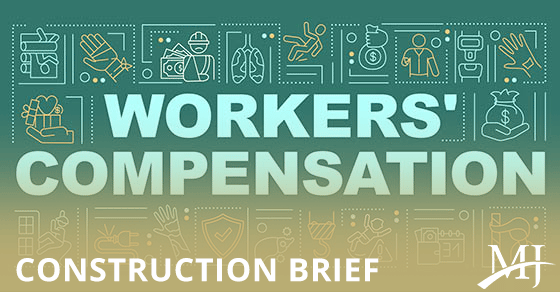Workers’ compensation insurance represents a major expense for construction companies. It might seem like there’s not much you can do to avoid high premiums. However, there are steps you can take to reduce or at least better control workers’ comp costs.
Ensure accurate employee classification
Insurers assign risk classification codes to employees based on their duties, responsibilities and level of exposure to the risk of injury or illness. Higher risk means higher premiums, so be sure that every one of your staff members is classified properly. If an employee who now works mainly from home is still classified as an on-site laborer, your premiums could be needlessly inflated.
Double-check your experience modifier
Insurers use experience modification rate — more commonly known as an “experience modifier” — to calculate workers’ comp premiums. It reflects your company’s loss history relative to industry average.
If you have an average loss history, your experience modifier will be 1.0. A higher-than-average loss history will raise your modifier above 1.0, increasing your premium; a lower-than-average loss history will have the opposite effect. Find out how your insurer determines its modifier and verify that the calculations are accurate.
Develop a robust safety program
The most effective way to reduce workers’ comp costs is to avoid accidents and injuries. That’s why it’s critical to develop a solid safety program that follows the Occupational Safety and Health Administration’s construction industry standards.
Train new hires thoroughly on safety protocols and procedures, as well as on the proper use of any construction equipment they’ll be using. From there, provide ongoing training and education as much as possible. Once your program is up and running, review and evaluate your safety performance regularly and update the program as necessary.
Even the strongest safety standards are effective only if they’re followed and enforced, so it’s essential to make the safety program part of company culture. This means setting the tone at the top. Communicate to employees your personal commitment to not only following safety guidelines, but also reporting accidents or injuries promptly. If employees are hesitant to report injuries, or they feel pressure to “work through the pain,” your workers’ compensation claims could eventually balloon in number and magnitude.
Building safety into your culture involves sound hiring and training processes, too. By discussing your company’s expectations regarding safety during interviews, you can get a feel for an applicant’s proclivity for risky behavior. Training should emphasize safety practices and, as mentioned, underscore the importance of prompt reporting of accidents and injuries.
Establish a return-to-work program
As the amount of time injured workers are off the job increases, their claims for lost wages will also go up while the likelihood of their return diminishes. A formal return-to-work program can help you retain employees and control workers’ comp claims.
These programs help reintegrate injured workers into the workforce as soon as possible, typically in less physically demanding roles and often on a reduced schedule. If an employee’s earnings will be lower during this period, some insurers are willing to make up the difference. The result: Injured workers return to their regular duties more quickly, reducing the costs of claims and minimizing the impact on your premiums.
Identify the right strategies
Many other types of businesses have converted employees to remote workers over the last couple of years, drastically reducing their odds of a workplace accident. By and large, construction companies don’t have this luxury. Contact us for help assessing your workers’ comp costs and identifying strategies for lowering them.
© 2022




